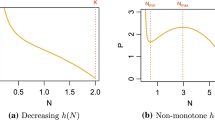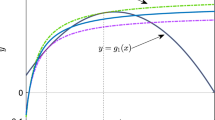Abstract
A two species predator-prey model is proposed incorporating the notions of mutual interference among predators as well as a density-dependent predator death rate. The latter leads to a curved predator isocline. Conditions for an interior equilibrium are given, and the stability of this equilibrium is analyzed. Certain critical cases, some of which cannot occur in the usual model are also discussed.
Similar content being viewed by others
Literature
Albrecht, F., H. Gatzke, A. Haddad and N. Wax. 1974. “The dynamics of Two Interacting Populations.”J. Math. Analysis Applic.,46, 658–670.
Armstrong, R. A. 1976. “The Effects of Predator Functional Response and Prey Productivity on Predator-Prey Stability: a Graphical Approach.”Ecology,57, 609–612.
Bulmer, M. G. 1976. “The Theory of Prey-Predator Oscillations.”Theor. Pop. Biol.,9, 137–150.
Beddington, J. R., 1975. “Mutual Interference between Parasites or Predators and its Effects on Searching Efficiency.”J. Anim. Ecol.,44, 331–340.
Diamond, P. 1974. “Area of Discovery of an Insect Parasite.”J. Theor. Biol.,45, 467–471.
Freedman, H. I. 1975. “A Perturbed Kolmogorov-type Model for the Growth Problem.”Math. Biosci.,23, 127–129.
— 1976. “Graphical Stability, Enrichment, and Pest Control by a Natural Enemy.”Math. Biosci.,31, 207–225.
Freedman, H. I. and P. E. Waltman. (preprint). “Predator Influence on the Growth of a Population with Three Genotypes.”
Gause, G. F., N. P. Smaragdova and A. A. Witt. 1936. “Further Studies of Interaction between Predators and Prey.”J. Anim. Ecol.,5, 1–18.
Gilpin, M. E. 1974. “A Model of the Predator-Prey Relationship.”Theor. Pop. Biol.,5, 333–344.
Hassell, M. P., 1971. “Mutual Interference between Searching Insect Parasites.”J. Anim. Ecol.,40, 473–486.
—, J. H. Lawton and J. R. Beddington. 1976. “The Components of Arthropod Predation I. The Prey Death-Rate.”J. Anim. Ecol.,45, 135–164.
— and G. C. Varley. 1969. “New Inductive Population Model for Insect Parasites and its Bearing on Biological Control.”Nature,223, 1133–1137.
Kolmogorov, A. 1936. “Sulla Teoria di Volterra della Lotta per l'Esistenza.”Gior. Inst. Ital. Attuari,7, 74–80.
Lefschetz, S. 1957.Differential Equations: Geometric Theory. New York: Interscience.
Loud, W. S. 1964. “Behavior of the Period of Solutions of Certain Plane Autonomous Systems near Centers.” InContributions to Differential Equations, Vol. III, pp. 21–36. New York: Wiley-Interscience.
May, R. M. 1973. “Qualitative Stability in Model Ecosystems.”Ecology,54, 638–641.
Nemytskii, V. V. and V. V. Stepanov. 1960.Qualitative Theory of Differential Equations. Princeton: Princeton University Press.
Noy-Meir, I. 1975. “Stability of Grazing Systems: an Application of Predator-Prey Graphs.”J. Ecol.,63, 459–481.
Oaten, A. and W. W. Murdoch. 1975. “Functional Response and Stability in Predator-Prey Systems.”Am. Nat.,109, 289–298.
Poore, A. 1976. “On the Theory and Application of the Hopf-Friedrichs Bifurcation Theory.”Archs Ration Mech. Analysis,60, 371–393.
Rogers, D. J. and M. P. Hassell. 1974. “General Models for Insect Parasite and Predator Searching Behaviour: Interference.”J. Anim. Ecol.,43, 239–253.
— and S. Hubbard. 1974. “How the Behaviour of Parasites and Predators Promotes Population Stability.” InEcological Stability (Usher, M. B. and M. H. Williamson, Eds.), pp. 99–119. London: Chapman and Hall.
Rosenzweig, M. L. 1972. “Reply to McAllisteret al.”Science,175, 564–565.
— and R. H. MacArthur. 1963. “Graphical Representation and Stability Conditions of Predator-Prey Interactions.”Am. Nat.,47, 209–223.
Royama, T. 1971. “A Comparative Study of Models of Predation and Parasitism.”Res. Pop. Ecol., Sup.I, 1–91.
Strebel, D. E. and N. S. Goel. 1973. “On the Isocline Methods for Analyzing Prey-Predator Interactions.”J. Theor. Biol.,39, 211–239.
Tanner, J. T. 1975, “The Stability and the Intrinsic Growth Rates of Prey and Predator Populations.”Ecology,56, 855–867.
Veilleux, B. G. 1976. “The Analysis of a Predatory Interaction betweenDidinium andParamesium.” M.S. Thesis, University of Alberta.
Watt, K. E. F. 1959. “A Mathematical Model for the Effect of Densities of Attacked and Attacking Species on the Number Attacked.”Can. Ent.,91, 129–144.
Wollkind, D. J. 1976. “Exploitation in Three Trophic Levels: an Extension Allowing Intraspecies Carnivore Interaction.”Am. Nat.,110, 431–447.
Author information
Authors and Affiliations
Rights and permissions
About this article
Cite this article
Freedman, H.I. Stability analysis of a predator-prey system with mutual interference and density-dependent death rates. Bltn Mathcal Biology 41, 67–78 (1979). https://doi.org/10.1007/BF02547925
Received:
Revised:
Issue Date:
DOI: https://doi.org/10.1007/BF02547925




